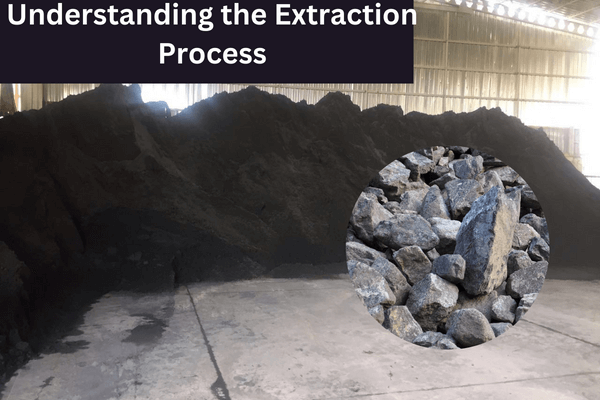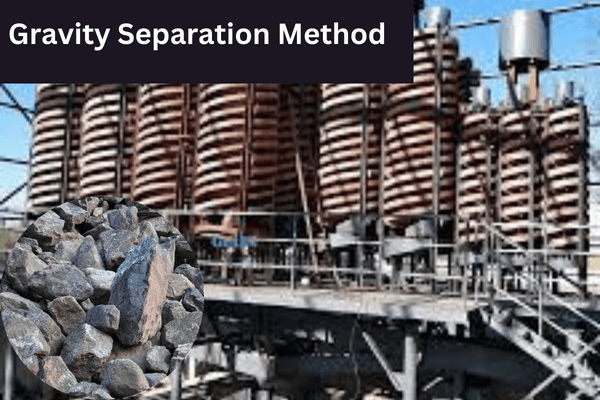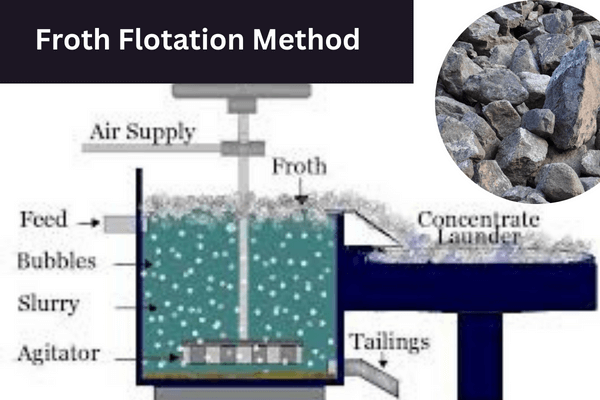Methods of Chromite Ore Extraction: A Detailed Overview
Introduction:Methods of Chromite Ore Extraction
Chromite Ore – it’s not just any ordinary mineral. It’s the primary source of chromium, an essential element used in the production of stainless steel, and a host of other products. Imagine your kitchens without those shiny, rust-resistant surfaces, that’s the magic of chromium, which originates from Chromite Ore. Apart from steel, chromium is also used in chrome plating and as a pigment in glass – making Chromite Ore an indispensable mineral in our daily lives.
We had traditional drilling methods, and environmental concerns weren’t as pronounced. But as technology advanced, we began integrating more advanced and environmentally-friendly extraction techniques. Magnetic separation, gravity concentration – these methods were developed to ensure that the extraction process was efficient and left minimal impact on Mother Nature. Let’s explore different methods of chromite ore extraction:
Buy chromite ore in various grades from Iran Chromite Group, available in lump or fine sizes. We will provide multiple inspection reports, such as SGS and CIQ reports, along with a solid contract.

Understanding the Extraction Process
Chromite ore is a mineral that contains the metallic element chromium. It is the primary source of chromium, an essential element used in various applications, most notably in the production of stainless steel due to its corrosion-resistant properties. Chromium, derived from chromite ore, is also used in chrome plating, as a pigment in glass, and in several other products. The chemical composition of chromite is FeCr₂O₄, meaning it contains iron, chromium, and oxygen.
Read more: What is Chromite Ore and Where is it Found?
Basics of Mineral Extraction
Mineral extraction is – in layman’s terms – getting the good stuff out of the ground. You dig into the earth, find the ore, and then separate the desired mineral – in our case, chromite – from the surrounding rock.
Now, how do we do that? There are several methods, and the choice often depends on the ore’s location and composition. Common methods include underground mining, open-pit mining, and placer mining. For chromite specifically, it’s mostly extracted through underground and open-pit mining.
You might wonder, “Why not just dig everywhere?” Well, before the extraction begins, there’s a lot of geological surveying and sampling. I’ve spent countless hours looking at samples, trying to figure out the best places to start digging.
Significance of Efficient Chromite Extraction
You see, extracting more chromite with less effort means less waste, fewer resources consumed, and a reduced environmental footprint. Every time we find a more efficient extraction method or tweak an existing one to make it better, we’re doing a massive favor for Mother Nature. We’re making sure that we’re not just plundering the earth haphazardly.
On the business side of things; the more efficiently we can extract chromite, the better the profit margins. And in the competitive world of mineral exports, that can make a world of difference. There have been times when a slight improvement in extraction efficiency turned a struggling mine into a thriving one.
Lastly, efficient extraction ensures a steady supply of chromite for various industries. It’s not just about shiny metals; chromite has a role in areas ranging from metallurgy to refractory applications. So, the better we get at extracting it, the smoother things run in many sectors.

Gravity Separation Method
Principle and Working
When you’re dealing with chromite ore, it’s like sifting gold from dirt. We rely on a tried-and-true technique called gravity separation. Think of it like using a sieve in the kitchen. First, the ore gets crushed and ground down. Then, it’s all about letting nature do its thing. We introduce this pulverized mixture to devices like spiral chutes and wobbly tables. The weighty chromite bits, being heavier, naturally sink to the bottom. Voila! The lighter unwanted bits, or ‘gangue minerals’ as they’re known, stay up top and get separated. Just like that, the chromite stands apart, ready for the next steps.
Pros and Cons of Gravity Separation
The pros: Firstly, it’s cost-effective. You’re not shelling out big bucks on chemicals or other expensive items. Plus, it’s environmentally friendly since no harmful chemicals are used. And the equipment? Durable and requires minimal maintenance.
The cons: It’s not always 100% effective for very fine particles. Sometimes, those sneaky little grains just don’t want to be separated, and we end up with impurities. Furthermore, it might not be the best choice if the difference in density between chromite and the surrounding materials isn’t that significant.
Modern-day Enhancements to this Method
Modern systems now incorporate advanced machinery like centrifugal concentrators, jigs, and shaking tables. These methods amplify the gravity difference and increase the efficiency of the separation process. Especially those centrifugal concentrators – they’re like spinning vortexes that give the ore one wild ride and separate the minerals with finesse.
But perhaps the most promising enhancement has been computer modeling. Yes, we can now predict and optimize the separation process before a single speck of ore even sees the light of day. It’s like having a crystal ball, but for mining. The future’s looking bright, I must say!

Magnetic Separation Technique
Magnetic separation is a fascinating process that harnesses the distinct magnetic attributes of ore minerals to isolate valuable minerals from unwanted, non-magnetic particles. Imagine this: every material reacts to a magnetic field in some manner. However, for many substances, this reaction is so minute that it often goes unnoticed.
Materials can be grouped into two main categories based on their reaction to magnetic fields: paramagnetic and diamagnetic. The former is strongly affected by magnetic fields, while the latter experiences only a minimal effect.
Now, let’s dive a little deeper. The power behind a magnet that directs its force through a material is known as field intensity. When we think about a magnet pulling a specific mineral towards it, it’s not just the strength of the magnetic field that matters. Equally important is the field gradient, which denotes how quickly the field strength amplifies as we move closer to the magnet’s surface.
Here’s a simple way to picture it: to achieve a set lifting force on a particle, there’s not just one, but countless ways to balance field strength and gradient. For those designing separators, it’s crucial to ensure both a strong field and a steep gradient for optimum performance.
Suitability for Chromite Ore
Now, when we talk about chromite ore, I must admit—it’s a tricky one. You see, chromite itself is not magnetic . . . but some associated minerals in its ore are. So, while it’s not the first technique I’d jump to for chromite extraction, under certain conditions, it can be effective. If the ore contains iron-bearing minerals, those can be separated out using this technique, leaving a richer concentration of chromite. So, it’s like sifting through the mess and finding the gems.
Advantages and Disadvantages
On one hand, magnetic separation is super efficient for certain types of ores. It’s also environmentally friendlier than some other methods—no chemicals, you know? And I’ve always appreciated how it offers a continuous and automated process. Less manual labor – which, between you and me, is a relief after long days in the mine!
But, on the flip side, it isn’t perfect. Like I mentioned, it’s not the top choice for chromite because the ore isn’t inherently magnetic. Plus, it can sometimes lead to a loss of valuable minerals if they’re magnetically close to waste minerals.

Froth Flotation Method
Fundamentals of Froth Flotation
Froth flotation, in a nutshell, is a process where valuable mineral particles are separated from worthless ones. Here’s the deal – ore is first ground into fine particles and then mixed with water to create a slurry. Then, we introduce some chemicals (more on that in a moment) and air into the mix. As the air bubbles rise, certain mineral particles attach themselves to these bubbles and are carried up to the surface. The result? A frothy layer on top containing those valuable minerals, while the unwanted gangue sinks to the bottom. It’s a bit like watching cream rise to the top of milk, except here, it’s all about getting those precious mineral particles!
The Role of Collectors and Frothers
Now, you might be wondering – how do the minerals decide which bubbles to hitch a ride on? Ah, that’s where the chemicals – collectors and frothers – come into play. Collectors, as their name suggests, “collect” the mineral particles by making them water-repellent. So, when air bubbles rise through the slurry, these water-repellent minerals are more than eager to stick to them. Frothers, on the other hand, stabilize the froth. They ensure that it lasts long enough for the separated minerals to be removed. It’s like adding a bit of magic to ensure the show goes on!
Applications in Chromite Ore Extraction
So, how does all this tie into chromite ore extraction, you ask? Well, I’ve had my fair share of exporting chromite products, and let me tell you, froth flotation is a crucial step in many chromite ore processing plants. Chromite, being a valuable and sought-after mineral, needs to be separated from other impurities. By tailoring the type and amount of collectors and frothers used, it’s possible to effectively extract chromite particles using froth flotation. This method isn’t just about getting the job done – it’s about maximizing the yield and ensuring the highest quality of chromite is obtained.
Hydrometallurgical Methods
Hydrometallurgy is a branch of metallurgy that involves the use of aqueous chemistry to extract metals from ores, concentrates, or even recycled or residual materials. The term “hydro” hints at water, and that’s a central component here. The whole idea revolves around the fact that metals can dissolve in solutions, especially when certain chemical reactions take place.
Moving on to the Processes Involved in the Extraction
Hydrometallurgical processes can be divided into three main stages: leaching, solution purification, and metal recovery. First, there’s leaching, where the ore or concentrate is treated with a suitable solvent (like an acid or alkali) which dissolves the desired metals. Once we’ve got our metals in solution, we then need to separate them from all the other junk – that’s the solution purification stage. Think of it as a sort of ‘cleanup crew’. Finally, metal recovery involves getting our dissolved metals out of the solution and into a more useful form. This could involve processes like precipitation, electrowinning, or even solvent extraction. It’s fascinating to see how metals can be teased out from their ores using just solutions and chemistry.
The method can sometimes be expensive due to the chemicals used, and environmental concerns arise when dealing with waste solutions. The benefits! Hydrometallurgy often allows for the extraction of metals at much lower temperatures than pyrometallurgy. Plus, the capability to treat refractory ores and produce high-purity metals? That’s a game-changer in many cases. And let’s not forget, for certain ore types, hydrometallurgy is the only feasible extraction method! So, while it has its challenges, the rewards often make it worth the effort.
Smelting and Pyrometallurgy
Basics of Smelting Processes
Smelting, in the simplest terms, is the process of extracting metal from its ore by heating it up. The ore is mixed with other substances called flux, which helps to separate the metal from the other elements in the ore. The outcome? A molten form of the metal, which is then cooled and solidified. But here’s the thing—smelting isn’t just a one-size-fits-all process. Different metals require different smelting techniques.
Chromite Ore Processing using Pyrometallurgy
Now, onto the real deal – Chromite ore and pyrometallurgy:
With chromite, pyrometallurgy typically involves the reduction of the ore with carbon in an electric arc furnace. This is a high-temperature process, and what we’re left with is ferrochrome – an alloy of iron and chromium, which has a myriad of industrial applications.
Efficiency and Environmental Considerations
High-temperature processes, like those in pyrometallurgy, tend to emit greenhouse gasses and other pollutants. Over the years, I’ve seen a shift in the industry towards cleaner and more sustainable practices. It’s a challenge, I won’t deny it. But if there’s anything my years in the field have taught me, it’s that innovation is at the heart of the mining and minerals sector. We’re constantly looking for ways to be both efficient and environmentally responsible. It’s a tightrope walk, but hey, that’s what keeps things interesting, right?
Heap Leaching Technique
Overview of Heap Leaching
Heap leaching, in its most basic form, is a process where metals are extracted from ore by trickling a leaching solution over a heap of crushed ore. The solution, usually a dilute acid or cyanide, dissolves the metal, and it’s then collected at the base of the heap. Kinda reminds me of those times when I’d watch water filter through coffee grounds, but, you know, on a much grander and chemical-laden scale!
Suitability for Chromite Ore
Heap leaching isn’t the go-to method for chromite extraction—mostly because chromite isn’t that reactive with the common leaching agents. But that doesn’t mean it’s a total no-go. With the right conditions and tweaks, it can still work, albeit not as efficiently as, say, for gold or copper. Still, in certain situations, especially when dealing with low-grade chromite ores, heap leaching might be a feasible option.
Advantages and Limitations
The advantages? For starters, heap leaching is less capital intensive compared to many other extraction methods. And when you’ve got a vast amount of low-grade ore, it can be quite cost-effective. It’s like getting a good deal on a bulk purchase—you know the thrill!
However, heap leaching can be slow. I mean, watching-paint-dry slowly. Additionally, it might not achieve as high metal recovery as other methods. And let’s not even get started on the environmental concerns; the potential for groundwater contamination is real. Always a trade-off, isn’t it?
Innovations in Chromite Ore Extraction
Over the past decade, I’ve watched it transform right before my eyes, and let me tell you, it’s nothing short of remarkable. The industry has come a long way from the days of manual labor and rudimentary techniques.
Recent Technological Advancements
Nowadays, we have state-of-the-art machinery that has significantly increased the efficiency of extraction processes. Drones, for instance, are now used for aerial surveys, giving us a bird’s eye view of potential mining sites. It’s almost like playing a video game, but this is real life! Automated drilling systems have been another game changer. They ensure precision, reduce waste, and, believe me, save a ton of time. And let’s not even get started on the advanced data analytics platforms; they provide insights that make decision-making a breeze. It feels like yesterday when we used to rely solely on intuition and experience – now, data backs up every move.
Green and Sustainable Methods
We’re now using more environmentally-friendly methods of extraction. Back in the day, the environmental impact of mining was… well, not something we were particularly proud of. But today, with bioleaching, we’re making use of microorganisms to extract metals from their ores, reducing the need for harmful chemicals. It’s a win-win, really: good for the planet and great for business. Water conservation techniques and waste reduction strategies have also been integrated into the process. It’s heartwarming to see the industry I love so dearly, taking steps to ensure a cleaner and healthier planet.
Conclusion:Methods of Chromite Ore Extraction
Chromite ore is the primary source of chromium, essential for producing stainless steel. Traditional drilling methods evolved into environmentally-friendly extraction techniques like magnetic separation and gravity concentration. The methods of chromite ore extraction such as underground mining and open-pit mining, following geological surveying. Efficient extraction is crucial for reducing environmental impact and ensuring profitability. Gravity separation, magnetic separation, froth flotation, hydrometallurgy, smelting, pyrometallurgy, and heap leaching are key extraction methods. The industry has seen recent technological advancements, emphasizing efficiency and sustainability.
